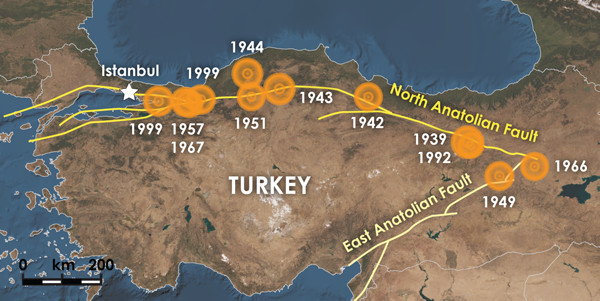
by Mary Caperton Morton Tuesday, August 19, 2014

The North Anatolian Fault Zone is one of the most active, and potentially deadly, fault zones in the world. Credit: Kathleen Cantner, AGI.
For decades, Istanbul has been bracing for a major earthquake from the dangerously active North Anatolian Fault, which passes just 20 kilometers south of Turkey’s largest city. A new study looking at the age of the fault zone may set a cap on the maximum quake size that could hit Istanbul, suggesting that the older, more mature sections of the zone in the east are capable of bigger earthquakes than the younger sections in the west, which are near the city.
The North Anatolian Fault Zone (NAFZ) is a transform boundary between the Eurasian and Anatolian plates that runs 1,200 kilometers from its junction with the East Anatolian Fault in eastern Turkey, across northern Turkey and out into the Aegean Sea. Since the deadly Erzincan earthquake in 1939, a string of multiple earthquakes, each greater than magnitude 7.0, has occurred along the fault zone, progressively moving westward toward Istanbul.
To study the age and evolution of the North Anatolian Fault Zone, Marco Bohnhoff, a geophysicist at the German Research Center for Geosciences in Potsdam, and colleagues turned to the region’s extensive historical earthquake records, which date back more than 2,000 years. By combining records of past earthquakes with field data on the cumulative offset of the two sides of the fault, they determined that the NAFZ originated in the east about 12 million years ago and migrated westward. The western sections are much younger and likely only reached the area of modern-day Istanbul about 1 million years ago.
This east-to-west age progression may have some implications for the maximum magnitude quake that could strike Istanbul, Bohnhoff says, as only the older, more mature sections of transform faults are thought to be capable of producing earthquakes greater than magnitude 7.5.
“It has been argued for decades that fault systems may unify smaller fault segments as they evolve over geological time, forming mature rupture zones with a potential for larger earthquakes,” says Bohnhoff, who presented his team’s findings at the annual meeting of the Seismological Society of America in Anchorage, Alaska, in April.
“While the western sections haven’t ruptured greater than a magnitude-7.4, at least in the past 2,300 years,” he says, “the historical earthquake catalog shows that the largest earthquakes on this fault system have all occurred in the eastern sections.”
Mature transform faults are loosely defined as those that have accumulated an offset — the distance the two sides have moved away from one another — of at least 80 kilometers, Bohnhoff says. Paleoseismic work shows that the eastern sections of the NAFZ have been offset by as much as 90 kilometers while the sections around Istanbul have only been offset by about 20 kilometers.
“This [age progression] had been tested before with theoretical models based on lab measurements, but it had not yet been confirmed with actual field data,” Bohnhoff says.
Mature transform faults are thought to be capable of producing larger earthquakes because they can rupture longer sections all at once. “Older faults often show signs of having simplified themselves, with fewer junctions and impediments to rupture,” says Thomas Parsons, a geophysicist with the U.S. Geological Survey in Menlo Park, Calif., who was not involved with the new study. The time needed to mature varies considerably from one fault system to the next, he says, but generally it takes millions of years.
“This idea that fault maturity produces bigger earthquakes still needs a lot more research,” Parsons says, particularly at other transform margins, like the San Andreas Fault, a transform fault with a similar length and slip rate to the NAFZ. In some places along the San Andreas Fault, maturity seems to have smoothed the two sides of the fault so much that they slip past one another aseismically and produce no earthquakes, Parsons says.
Determining a similar age progression for the San Andreas Fault is hindered by the much shorter historical and paleoseismic records, which only go back a few hundred years. Paleoseismic studies have suggested that the southern sections of the fault around Los Angeles are the oldest, dating to about 30 million years, Parsons says. “Our model seems to fit the San Andreas Fault, with some of the biggest earthquakes occurring in the older sections, but it needs more study,” Bohnhoff says.
As for Istanbul, identifying the maximum magnitude quake that might strike the eastern sections of the fault may help seismologists create a more accurate hazard profile for the city, Bohnhoff says. “We propose that the magnitude can be as large as 7.4 or 7.5 but will likely not be larger. Of course, a 7.4 is still a major earthquake, but a magnitude-8 quake is an exponentially greater seismic hazard.”
© 2008-2021. All rights reserved. Any copying, redistribution or retransmission of any of the contents of this service without the expressed written permission of the American Geosciences Institute is expressly prohibited. Click here for all copyright requests.